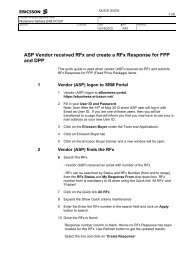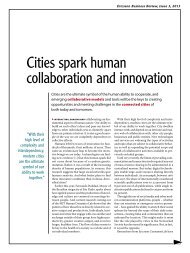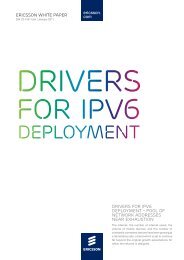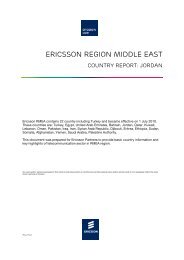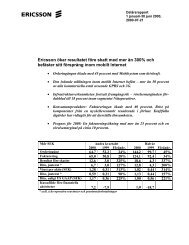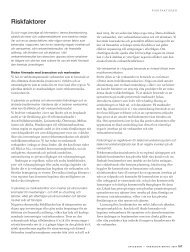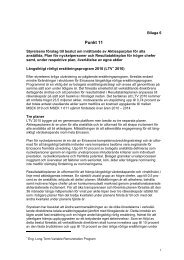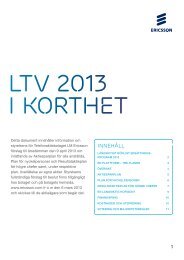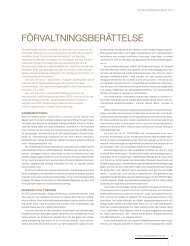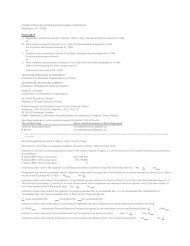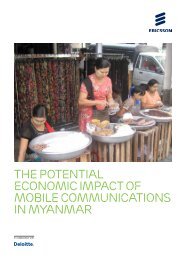Telenor's - Ericsson
Telenor's - Ericsson
Telenor's - Ericsson
- TAGS
- ericsson
- www.ericsson.com
Create successful ePaper yourself
Turn your PDF publications into a flip-book with our unique Google optimized e-Paper software.
little – if any – growth in revenues. Telstra,<br />
on the other hand, has invested in the cables<br />
and routes and can now leverage off these<br />
assets and enhance transmission capacity relatively<br />
cheaply and flexibly.<br />
New technology breakthroughs are also<br />
providing further cost savings for Telstra.<br />
The vast distances involved in many routes<br />
across Australia mean that a chain of<br />
optical repeaters must be used to create<br />
the transmission path, and historically<br />
Telstra had spaced these repeater sites at<br />
50km intervals.<br />
New transmission equipment can span<br />
much longer distances. Consequently, a<br />
program to eliminate intermediate repeater<br />
sites has begun, leaving optical spans of<br />
100km. A recently built section in the<br />
remote Arnhem Land area in northern Australia<br />
has a span of 200km. The benefits of<br />
fewer repeater sites include enhanced reliability,<br />
saving on building maintenance and<br />
site rent and reduced energy consumption<br />
and emissions.<br />
So, despite the somewhat higher power<br />
lasers and optical amplifiers required to span<br />
these longer distances, the net result is a reduction<br />
in capital and operational expenditure,<br />
emissions and an overall improvement<br />
in link performance.<br />
SUPPORTING NEW BUSINESS<br />
The business benefits for Telstra go beyond<br />
simple cost savings. Telstra has now built a<br />
national transmission network that covers<br />
every town and city in Australia; a network<br />
that has ample capacity, and on which scalability<br />
for growth is largely decoupled from<br />
equipment investment spending. New network<br />
services can be rolled out rapidly, and<br />
at low incremental cost.<br />
For example, from 2006 to 2010, the network<br />
has been leveraged to support annual<br />
speed increases on 3g mobile broadband from<br />
3.6Mbps to 14.4Mbps to 21Mbps to 42Mbps.<br />
The scalability of the national transmission<br />
network and the fact that the majority<br />
of mobile base stations now have gigabit Ethernet<br />
interfaces, means Telstra has been able<br />
to repeatedly increase the speeds of the 3g<br />
hspa access network without a specific transmission<br />
upgrade program. Instead, capacity<br />
has been increased incrementally as part of<br />
the ongoing updating of transmission speeds<br />
from 2.5Gbps to 10Gbps to 40Gbps.<br />
As an early adopter of the next generation<br />
of mobile telephony msc-s nodes, which are<br />
used to establish telephone calls through the<br />
mobile network, Telstra is transforming the<br />
mobile network core from 18 msc-s nodes<br />
deployed all over the country, to four nodes<br />
deployed in two diverse locations, to create<br />
a national pool. This means considerable sav-<br />
ings. Such a highly centralized network is<br />
only possible because the underlying transmission<br />
network is reliable and has more<br />
than enough capacity to support the traffic,<br />
even under “fail over” conditions.<br />
The new transmission network is also the<br />
foundation for Telstra’s new iptv service. To<br />
support the delivery of content for its new T-<br />
Box service, Telstra is building a content distribution<br />
network (cdn) that caches video<br />
content at key transmission points around<br />
Australia. Telstra has introduced the cdn<br />
quickly, because the transmission architecture<br />
is well suited to hosting the cdn server<br />
farms at the access edge and because the scalability<br />
of the transmission network means<br />
that no special transmission upgrade program<br />
is required. Rather, the video capacity<br />
requirements are simply rolled into the overall<br />
capacity growth program.<br />
The network strategy adopted by Telstra<br />
is not limited to exploiting cost efficiencies.<br />
It is firmly grounded in the operator’s future<br />
business requirements. Telstra’s success with<br />
its network transformation is a lesson about<br />
the close connection between network strategy<br />
and business benefits, as well as between<br />
technology solution provider and carrier. ●<br />
AUTHOR<br />
▶ COLIN GOODWIN is<br />
Broadband Strategy Manager<br />
for <strong>Ericsson</strong> Australia-NZ,<br />
responsible for the Fixed and<br />
Transmission product lines.<br />
He has more than 25 years of experience in telecommunications,<br />
first in technical development and support,<br />
then in consulting on technical and financial aspects<br />
of telecommunications strategy, and then in<br />
product development and management. Before joining<br />
<strong>Ericsson</strong> in 2001, he worked as a Senior Product<br />
Manager for Telstra. Colin has a Master of Engineering<br />
Science from Monash University, Australia.<br />
(colin.goodwin@ericsson.com)<br />
AUTHOR<br />
▶ MARK CHASELING is a<br />
Network Strategy Consultant<br />
specializing in fixed network<br />
transformation in Southeast<br />
Asia. He has more than 14<br />
years of experience in telecommunications, beginning<br />
in network operations, planning and technical<br />
development before moving into management and<br />
consulting. Before joining <strong>Ericsson</strong> in 2008, he<br />
worked as a Senior Engineer for T-Mobile International,<br />
responsible for defining its pan-European IP/<br />
MPLS commercial and technical strategy. Mark has<br />
an Honours degree in Telecommunications Engineering<br />
from the University of Technology in Sydney,<br />
Australia and a Master of International Business from<br />
Melbourne University, also in Australia.<br />
(mark.chaseling@ericsson.com)<br />
The brand sensitive issue<br />
of resilience<br />
broadband strategy<br />
▶ FROM TIME TO TIME, the telecoms<br />
industry sees reports of carriers that have<br />
experienced highly disruptive extended<br />
transmission outages. While the media tend<br />
to focus on the inconvenience to end users<br />
and the loss of service revenues to the operator,<br />
the main damage to the operator is a<br />
long-term loss of brand value and customer<br />
dissatisfaction.<br />
Telstra is acutely aware that the national<br />
transmission network is essential to the<br />
valuable revenues derived from the services<br />
that run over it. Telstra positions itself as<br />
providing premium services and its brand is<br />
synonymous with high quality and reliability.<br />
A decision was made in 2009 to enhance<br />
the resilience of the transmission network<br />
by adding further diverse routes between<br />
major cities. These “third routes” complement<br />
the existing coastal and inland routes<br />
between capital cities.<br />
This did not necessitate a major cablelaying<br />
program. Rather, the third routes are<br />
logical paths that make use of previously<br />
unused wavelengths and fi bers in existing<br />
cables. Consequently, deploying physically<br />
diverse routes between major cities only<br />
required small stretches of new cable to be<br />
laid and only a modest investment in new<br />
active transmission equipment.<br />
The existence of a well-structured hierarchical<br />
network and a consistent set of<br />
equipment with a common management<br />
system means a third route can be added<br />
quickly and economically. The project is due<br />
for completion in 2011.<br />
By comparison, many carriers have procurement<br />
processes that drive them to treat<br />
transmission purchases on a link-by-link<br />
basis, meaning they have a patchwork of<br />
transmission solutions and technologies<br />
and element management systems that<br />
defy integration. Such an approach makes<br />
innovative programs such as Telstra’s third<br />
routes impossible.<br />
Transmission network<br />
cost distribution<br />
Cables buildings<br />
power<br />
Transmission<br />
equipment<br />
Source: <strong>Ericsson</strong><br />
Civil works<br />
Typical cost breakdown from <strong>Ericsson</strong> global<br />
accounts.<br />
EBR #3 2010 47



